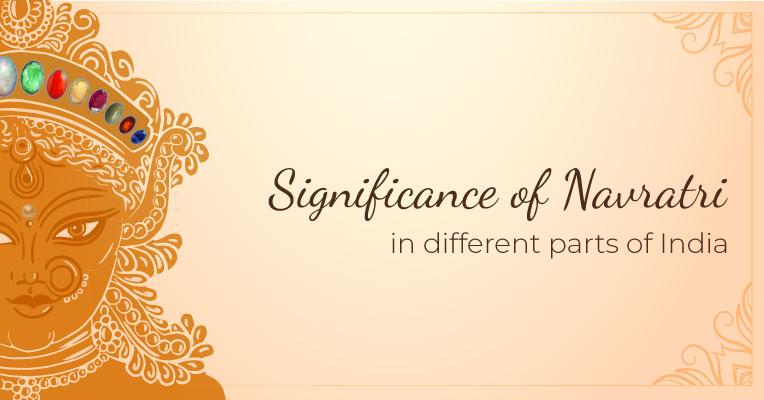India is all set to welcome the dawn of festival season from this 29th day of September, which marks the beginning of Navratri. Navratri is a festival of 9 days completely devoted to Goddess Durga and the nine Navratri days stand to signify her 9 avatars.
A time of extreme festivities, joy, and cheer in the Hindu Calendar, which brings good luck to the entire country. Navratri is considered as the beginning of the festival season in India. It is also popularly known as the Maha Navratri and it falls in the lunar month of Ashwin during Sharad Ritu. This autumn Navratri is considered as the most auspicious of all the four Navratri, the next one being the one which falls in the spring season in March-April.
Why is Navratri Celebrated?
Navratri is celebrated to honor the victory of Goddess Durga over the demon Mahishasura. It is thus a symbol of the triumph of peace and religion over evil. Different parts of the country associate it with different reasons. In the eastern and the north-eastern states, Navratri is considered synonymous with Durga Puja while in the northern and the western parts of the country it is celebrated as Ram Lila and Dussehra. In the southern part of the country, the victory of many different goddesses is celebrated. However, the underlying theme is the victory of good over evil.
NAVRATRI SIGNIFICANCE EACH DAY
Day 1: It stands for Goddess Shailputri. It is said that this avatar of Goddess Durga is the embodiment of the power of Brahma, Vishnu and Mahesh took collectively. Goddess Shailputri is thus worshipped as the consort of Shiva.
Day 2: It stands for Goddess Brahmcharini. In this avatar Goddess, Durga is said to become the step to the real emancipation of human life. She is said to bestow happiness, peace, prosperity and even grace.
Day 3: It stands for Goddess Chandraghanta who is said to represent beauty and grace. She is worshipped for bringing peace, tranquility, and prosperity in life and is said to be the symbol of bravery.
Day 4: It stands for Goddess Kushmunda. In this avatar Goddess, Durga is believed to be the creator of the Universe through laughter.
Day 5: It stands for Goddess Skand Mata. She is believed to be the mother of Skanda or Kartikeya who had been picked by the Gods to be the commander of the army in their war against the demons. Goddess Skand Mata symbolizes the power of a mother to go to any extent to save her children.
Day 6: It stands for Goddess Katyayani. She is believed to have been born to Kata, the great sage. In this avatar, Goddess Durga is said to dress in orange and shows great courage.
Day 7: It stands for Goddess Kalratri. In this avatar, Goddess Durga is said to have dark complexion, disheveled hair and is said to possess a fearless posture. It is said to be the fiercest form of Goddess and is dressed in white- a color which shows peace.
Day 8: It stands for Goddess Maha Gauri. She is the eighth avatar of Goddess Durga and is said to stand for intelligence, peace, calm and prosperity.
Day 9: It stands for Goddess Siddhidatri. She is said to possess supernatural powers and has a happy state of mind.
People usually celebrate the festival with great fervor, dressing up each day in the Navratri colors.
NAVRATRI CELEBRATIONS IN DIFFERENT PARTS OF INDIA
Navratri is a time to immerse yourself in the religious fervor and seek blessings of the Goddess by adorning the auspicious colors while enjoying all the rituals that are linked with it. Let us explore how different parts of India take up the festival.
Punjab: Navratri or Naratey as it is called in Punjab has a peculiar flavor. They usually dedicate their bhajans to the glory of Goddess Shakti which is often sung by staying awake all night in a ceremony called the Jagrata. People often fast for the first seven days and it is on the eighth day that Ashtami is celebrated where they finally call up their fasts and a small feast is observed for nine young girls and a boy. A red-colored scarf or a small chunni is often presented to the girls.
Delhi and UP: In other northern states as well, Navratri is celebrated by fasting for nine days. Ramlila is conducted in different fairs which are organized. This basically depicts the enactment of Ramayana. The fairs also hold other entertainment and eating stalls. It is on the last day of Dusshera that huge effigies of Ravana, Kumbhakarna and Meghanad are burnt in a bid to symbolize the victory of truth over evil.
Gujarat: Gujaratis make the country dance to their tunes of Garba and Dandiya Raas, a high energy dance which grooves people to the music and live orchestra. Dandiya is performed by people holding two sticks in their hands which in fact symbolizes the fight of Goddess Durga with the evil forces.
West Bengal, Assam, and Bihar: In eastern India, especially in the states of West Bengal, Assam, and Odisha Navratri is related to Durga Puja. The last four days of the festival are often associated with the Saptami, Ashtami, Navami and finally the Dashmi. Bengalis consider this as the biggest celebration of the year conducted on account of the victory of Goddess Durga over the infamous demon Mahishasur. Huge pandals are made to mark the festival and carry the idols of Goddess Durga, Lord Ganesha, Kartikeya, Goddess Lakshmi, and Goddess Saraswati. All the idols are immersed on the last day. Women usually dress up in red and white sarees and perform the much feverish dance known as the Dhunachi on drum beats.
Maharashtra: The Navratri has its own rituals and flavors in this part of the country. It begins with Ghatasthapana which comprises food grains sowing in clay. An earthen pot is placed in the center. The pot is filled with water. For nine days a puja of the pot is performed, post which the grains are collected and the pot is dissolved. Some parts of Maharashtra also conduct Kali Puja on the first two days. It is followed by Lakshmi Puja for three days. This is followed by Goddess Saraswati prayers offered on the remaining 4 days. Many times a woman is called from Matang community and she is offered food. She is said to represent Goddess Matangi who is expected to give blessings in return.
Karnataka: Dasara is famous in Mysore and is celebrated as Naada Habba in Karnataka during which huge processions of elephants, fairs and even many exhibitions of different handicrafts of other articles. It is on the final Navratri when Ayudha puja is conducted.in which the devotees worship their daily life implements which they use computers, books, vehicles, and kitchen tools.
Tamil Nadu: It is celebrated in customary style and known as Bommai Kolu in various south Indian states. Small Kolu dolls are displayed in every household on the steps. The courts of dolls depict everyday scenes and tales from Puranas and even royal processions in the divine presence of deities. One of the Kolu dolls is finally put to sleep on the final day of Vijayadashmi to commemorate the end of the celebrations.
Kerala: Being the most literate state of India, Kerala devotes a major part of the festival to Goddess Saraswati who is also the deity of knowledge. Books and many other musical instruments are kept in front of the deity and are also worshipped till the final day of Dashami. In Kerala, on the final day, even Vidyarambham is also celebrated on Dashami and children are typically introduced to music, languages and even learning of other folk arts. It is considered auspicious to start a new learning process.
Gemkart takes pride in bringing you the best quality gemstones linked with every Navratri color, and wishes you all a very Happy Navratri!













